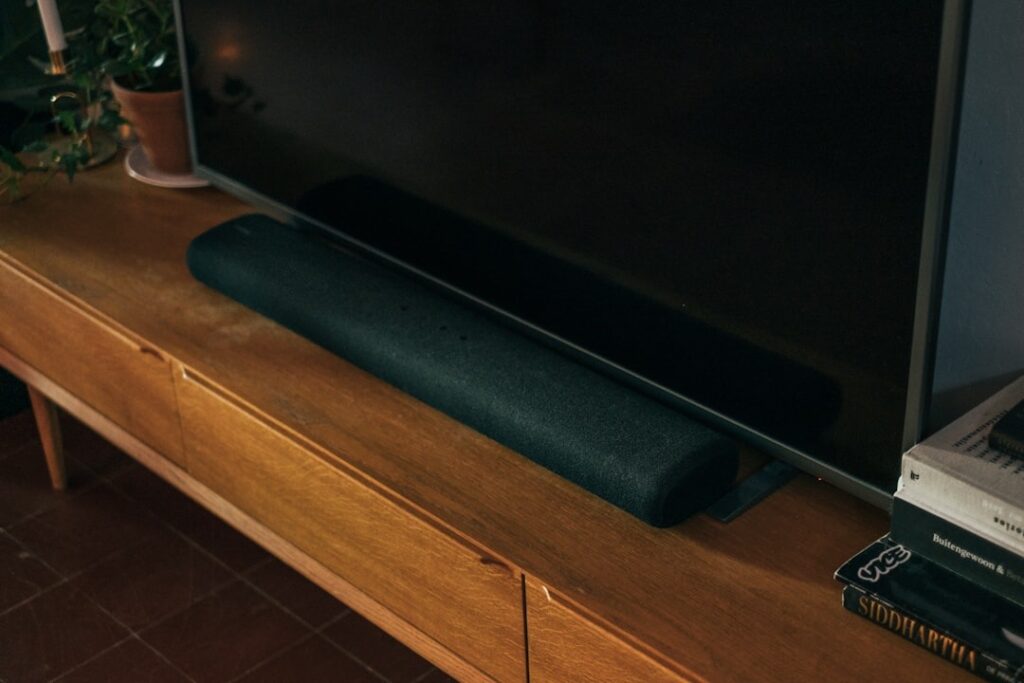A budget soundbar is the most impactful, yet affordable, upgrade you can make to your home entertainment setup. It dramatically improves dialogue clarity and overall audio depth compared to the weak built-in speakers of most modern flat-screen TVs.
However, a lower price point comes with certain trade-offs, like limited connectivity or the absence of advanced surround sound features. Read on for a simple guide to understanding those compromises so that you can get the best sound for your money.
Note: All price tiers refer to US Dollar ($) equivalents.

Price Tiers on Amazon for Budget Soundbars
1. Entry-level: Under $100
Basic stereo sound (2.0 channel). Best for small rooms, clear dialogue, and simple music playback. Minimal features, usually includes Bluetooth and Optical/AUX connection.
Find on Amazon: For two examples in this price bracket, check out these soundbars, the Assistrust KY-8000 Sound Bar for Smart TV and the TCL S45H S Class 2.0 Channel Sound Bar.
2. Mid-range: $100 – $250
Enhanced audio quality, often includes a separate wired or wireless subwoofer (2.1 channel). May feature virtual surround sound like DTS Virtual:X, or basic Dolby Digital support. Better connectivity (e.g. HDMI ARC).
Find on Amazon: A great value option offering this configuration is the Hisense HS2100 2.1ch
Core Specifications and Design
Budget soundbars prioritize function and simplicity.
Audio Channels and Specs
- Channel Setup: Most common configurations are 2.0 (stereo) or 2.1 (stereo with a separate or built-in subwoofer).True 5.1 or Dolby Atmos setups are rare in the entry-level range but start appearing in the mid-budget segment, often using virtualisation technology.
- Find on Amazon: The Samsung HW-C450 2.1ch is one such soundbar that uses the immersive audio technology, DTS Virtual:X, to create a 3D sound experience without needing extra surround or overhead speakers.
- Connectivity: This is critical. Look for HDMI ARC (Audio Return Channel) for the easiest one-cable connection and use of your TV remote for volume control. Virtually all models include Bluetooth for wireless music streaming and an Optical port for older TVs. Aux-in (3.5mm) and USB are also common.
- Power: Wattage ratings can be inconsistent, but generally, higher wattage points to louder potential volume. More important is how the system handles volume; many cheaper bars may introduce distortion at their highest levels.
Appearance and Build
- Design: Most budget bars are black, rectangular, and covered in a metallic grille or acoustic fabric. They are designed to be compact and low-profile to fit neatly under a TV without blocking the screen or IR sensor.
- Find on Amazon: If you’re looking for a white soundbar, check out the Sonos Ray White Compact Soundbar.
- Build Quality: While generally plastic, mid-budget models feel more substantial and less “flimsy.” Durability is generally good, as they are stationary devices. Physical damage from drops is the main risk.
Performance: What You Gain and What You Miss
The goal of a budget soundbar is simple: to make TV dialogue clearer and provide a fuller, richer soundstage than your TV can manage.
Expected Performance
- Dialogue Clarity: This is the biggest win. Dedicated front-facing drivers drastically improve the clarity of voices. Many models include a dedicated “Voice” or “Dialogue” EQ mode which makes it easier to understand dialogue without significantly altering background sounds or music.
- Bass Improvement: Even a basic 2.0 bar will offer better bass than a TV. A 2.1 system with a dedicated subwoofer, especially a wireless one, provides a noticeable thump to movie explosions and music.
- Volume: They can get significantly louder than your TV without sounding tinny or flat.
Other Features
- Sound Modes: Basic EQ presets (Movie, Music, Voice/News) are standard for optimizing sound based on content.
- Find on Amazon: The Sony HTS100F 2.0ch has a range of sound modes, including Voice which makes dialogue clearer.
- Simple Remote: Expect a small remote to manage volume, input, and sound modes.
- Display: Cheaper models may only have basic LED lights to indicate input/mode, while mid-budget options often feature a discrete digital display behind the grille.
Critical Caveats and Limitations
Be realistic about what a budget bar cannot do compared to premium models.
- No True Surround Sound: Virtual surround features (e.g. DTS Virtual:X) can widen the soundstage, but they rarely replicate the true immersion of a multi-speaker setup.
- Limited Deep Bass: While better than a TV, bass from built-in or small subwoofers won’t rattle the room like a high-end system.
- No Wi-Fi/Smart Features: Entry-level budget bars stick to Bluetooth for wireless audio. Features like Wi-Fi streaming, AirPlay 2, Chromecast, or built-in voice assistants (Alexa/Google) are generally non-existent for budget, audio-only bars at this price point.
- Find on Amazon: The few exceptions, such as a handful of streaming media soundbars (e.g. the Roku Streambar SE) integrate Wi-Fi to support their primary function as a video player.
- No HDMI Passthrough: You typically get one HDMI port (ARC), meaning you can’t connect a console/player through the soundbar to your TV.
Warranty and Durability
Standard Warranty
Most budget electronics from major brands on Amazon (Vizio, TCL, Sony, etc.) come with a 1-year limited manufacturer’s warranty covering defects in materials and workmanship. Be wary of off-brand items that offer shorter or difficult-to-claim warranties.
Durability
With proper care (e.g. protecting against power surges and keeping it dry), a budget soundbar should last for several years, easily exceeding its warranty period. Failure is typically due to a sudden component fault rather than wear and tear.
A budget soundbar is a sensible, high-value investment. By setting realistic expectations such as focusing on better dialogue, improved bass, and easy connectivity, you can find an excellent model on Amazon that instantly upgrades your viewing experience without draining your wallet.

